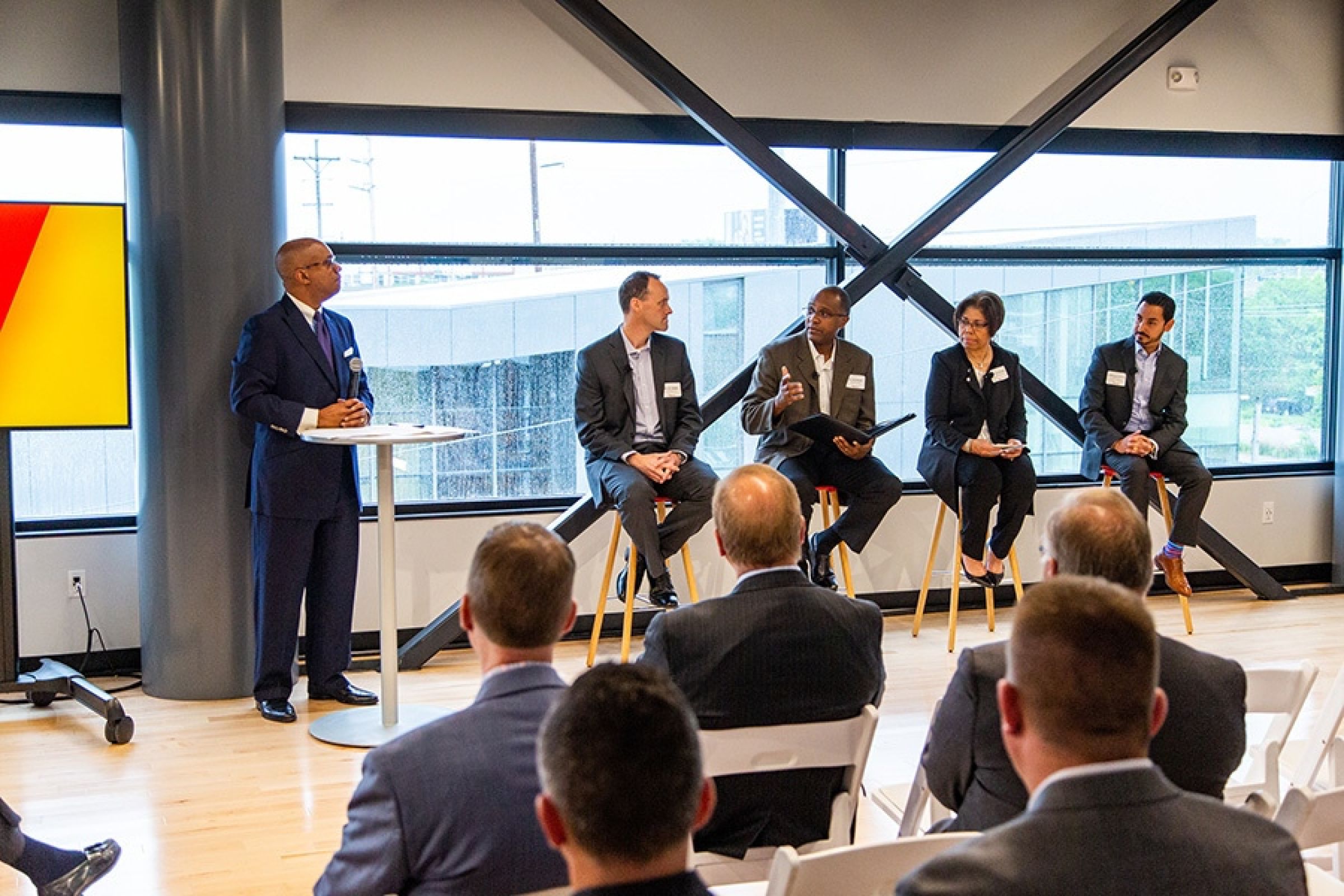June 19th, 2019
The importance of supplier diversity
In 2015, Forbes named Grand Rapids as the second worst city in the nation for African Americans to prosper. This came as a stark contrast to the long list of accolades the region receives on an annual basis. Our community has been tackling this topic head-on, but there is still a lot more work to be done. Which is why The Right Place recently hosted an Investor Breakfast at the West Michigan Center for Arts and Technology (WMCAT) on the topic of Supplier Diversity.

In 2015, Forbes named Grand Rapids as the second worst city in the nation for African Americans to prosper. This came as a stark contrast to the long list of accolades the region receives on an annual basis. Our community has been tackling this topic head-on, but there is still a lot more work to be done. Which is why The Right Place recently hosted an Investor Breakfast at the West Michigan Center for Arts and Technology (WMCAT) on the topic of Supplier Diversity. A panel of speakers provided insight on how and when companies should be diversifying not only their supply chain, but their business operations as a whole
The panel included:
- Guillermo Cisneros, Executive Director, West Michigan Hispanic Chamber of Commerce
- Derek Ludwig, Vice President of Global Procurement, Steelcase
- Brenda Marshall, Principal, Global Diversity Solutions, Kelly Services
- Joe Matthews, Vice President, Purchasing and Diversity Officer, Gentex
The panel was moderated by Skot Welch, Principal/Founder, Global Bridgebuilders.
Each of these panelists tackle the topic of diversity in different capacities within their organizations and brought unique perspectives to the morning’s discussion.
From top to bottom, who leads diversification?
The panelists agreed diversity initiatives come into existence at the hands of executive-level leadership. The decision makers of an organization are the ones with the ability to fuel, or stall, diversification efforts from the start. Stakeholder buy-in is a critical factor in the success of making diversity an effective and meaningful business strategy.
However, middle-management and the rest of the workforce are also vital to the success of diversification. While those at the top may create these concepts for their organizations, the people responsible for breathing life into them are those who are working on the ground, day-in and day-out.
This means the desire to diversify must come from all levels of the organization. If it doesn’t, implementation will fail as it gets lost in the mix of what’s both familiar and comfortable.
What does successful diversification look like?
For any supply chain to be successful, says Ludwig, it must be both competitive and sustainable. In that same vein, the individuals making up the supply chain must be able to approach problems in a way that drives an innovative solution.
Welch points towards studies that have found heterogeneous groups to be smarter and more innovative than those that are not. Innovation is born out of diverse thinkers collaborating together to solve a common problem.
The Hispanic community now accounts for nearly 17% of West Michigan’s population, according to Cisneros. His question for employers was whether or not their workforce reflects the true makeup of the community they’re in. This factor, Cisneros says, is a key indicator of successful diversification efforts.

Developing your diverse supply chain
Lack of diversity in supply chains is not a new problem, but even as conversations shift to diversification, many companies resist change because they feel minority suppliers do not have the capacity or skill to deliver what they’re accustomed to.
This is part of the process, the panelists say. As West Michigan businesses more frequently turn to minority-owned suppliers for their supply chain, they will need to take steps to develop strong, meaningful relationships with them. Putting in the time and effort to guide these suppliers forward, Ludwig says, can lead to diverse suppliers bringing even greater value to the table than traditional ones
When is the right time to diversify?
In short, the answer is now. The stars will not align to present you with the perfect time to make these changes, says Matthews. Companies should already be actively working to diversify their supply chains in a meaningful way.
In Marshall’s eyes, the ship has already sailed, and those who aren’t on board are going to be struggling to catch up, “If your company is not being inclusive or diverse, it’s not going to be able to effectively compete in the global marketplace,” she says.
Cisneros believes it’s not a matter of if companies choose to diversify, but when. Demographics are rapidly changing, and soon, more people will demand to know why businesses are not becoming more diverse, even as the community is. Whoever starts this transformation early will have an advantage in the years to come.
However, there are natural rhythms to the business cycle, and Ludwig proposes that companies who are not diversifying now have opportunities in the future that pose less barriers to entry for these suppliers. New product development, for example, is the perfect time to bring on a new supplier and work together with them to create a successful relationship.

The bigger picture
Rounding out the panel discussion, Cisneros asked attendees, “How are you investing in the diversity and talent development of our community?”
Ludwig pointed out that this challenge cannot be solved all at once. Small steps in the right direction will ultimately result in a rich and effective process for diversity and inclusion within your company.
“This is about keeping our community competitive; winning via a strategy of inclusion. It’s not just the right thing to do, it’s about creating value, creating competitiveness, and driving community wealth and growth,” said Birgit Klohs, President and CEO of The Right Place, “Safe is the new risky. Take a risk, take those first steps to help develop these businesses into what they have the potential to be.”